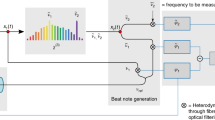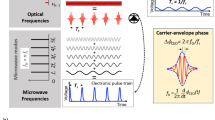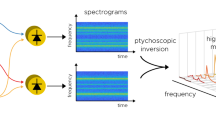Abstract
Two decades after its invention, the classic self-referenced frequency comb laser is an unrivalled ruler for frequency, time and distance metrology owing to the rigid spacing of its optical output1,2. As a consequence, it is now used in numerous sensing applications that require a combination of high bandwidth and high precision3,4,5. Many of these applications, however, are limited by the trade-offs inherent in the rigidity of the comb output and operate far from quantum-limited sensitivity. Here we demonstrate an agile programmable frequency comb where the pulse time and phase are digitally controlled with ±2-attosecond accuracy. This agility enables quantum-limited sensitivity in sensing applications as the programmable comb can be configured to coherently track weak returning pulse trains at the shot-noise limit. To highlight its capabilities, we use this programmable comb in a ranging system, reducing the required power to reach a given precision by about 5,000-fold compared with a conventional dual-comb system. This enables ranging at a mean photon per pulse number of 1/77 while retaining the full accuracy and precision of a rigid frequency comb. Beyond ranging and imaging6,7,8,9,10,11,12, applications in time and frequency metrology1,2,5,13,14,15,16,17,18,19,20,21,22,23, comb-based spectroscopy24,25,26,27,28,29,30,31,32, pump–probe experiments33 and compressive sensing34,35 should benefit from coherent control of the comb-pulse time and phase.
This is a preview of subscription content, access via your institution
Access options
Access Nature and 54 other Nature Portfolio journals
Get Nature+, our best-value online-access subscription
$29.99 / 30 days
cancel any time
Subscribe to this journal
Receive 51 print issues and online access
$199.00 per year
only $3.90 per issue
Buy this article
- Purchase on Springer Link
- Instant access to full article PDF
Prices may be subject to local taxes which are calculated during checkout





Similar content being viewed by others
Data availability
The data for the figures in this paper are available for download at https://data.nist.gov/od/id/mds2-2703.
Code availability
The mathematics and algorithms necessary to create a time-programmable frequency comb are described between the main text and Methods.
References
Hänsch, T. W. Nobel Lecture: Passion for precision. Rev. Mod. Phys. 78, 1297–1309 (2006).
Hall, J. L. Nobel Lecture: Defining and measuring optical frequencies. Rev. Mod. Phys. 78, 1279–1295 (2006).
Newbury, N. R. Searching for applications with a fine-tooth comb. Nat. Photon. 5, 186–188 (2011).
Fortier, T. & Baumann, E. 20 years of developments in optical frequency comb technology and applications. Commun. Phys. 2, 153 (2019).
Diddams, S. A., Vahala, K. & Udem, T. Optical frequency combs: coherently uniting the electromagnetic spectrum. Science 369, eaay3676 (2020).
Zhu, Z. & Wu, G. Dual-comb ranging. Engineering 4, 772–778 (2018).
Coddington, I., Swann, W. C., Nenadovic, L. & Newbury, N. R. Rapid and precise absolute distance measurements at long range. Nat. Photon. 3, 351–356 (2009).
Kim, W. et al. Absolute laser ranging by time-of-flight measurement of ultrashort light pulses. J. Opt. Soc. Am. A 37, B27–B35 (2020).
Minoshima, K. & Matsumoto, H. High-accuracy measurement of 240-m distance in an optical tunnel by use of a compact femtosecond laser. Appl. Opt. 39, 5512–5517 (2000).
Vicentini, E., Wang, Z., Van Gasse, K., Hänsch, T. W. & Picqué, N. Dual-comb hyperspectral digital holography. Nat. Photon. 15, 890–894 (2021).
Kato, T., Uchida, M. & Minoshima, K. No-scanning 3D measurement method using ultrafast dimensional conversion with a chirped optical frequency comb. Sci. Rep. 7, 3670 (2017).
Hase, E. et al. Scan-less confocal phase imaging based on dual-comb microscopy. Optica 5, 634–643 (2018).
Deschênes, J.-D. et al. Synchronization of distant optical clocks at the femtosecond level. Phys. Rev. X 6, 021016 (2016).
Giorgetta, F. R. et al. Optical two-way time and frequency transfer over free space. Nat. Photon. 7, 434–438 (2013).
Xin, M., Şafak, K. & Kärtner, F. X. Ultra-precise timing and synchronization for large-scale scientific instruments. Optica 5, 1564–1578 (2018).
Shen, Q. et al. Experimental simulation of time and frequency transfer via an optical satellite–ground link at 10−18 instability. Optica 8, 471–476 (2021).
Boulder Atomic Clock Optical Network (BACON) Collaboration Frequency ratio measurements at 18-digit accuracy using an optical clock network. Nature 591, 564–569 (2021).
Clivati, C. et al. Common-clock very long baseline interferometry using a coherent optical fiber link. Optica 7, 1031–1037 (2020).
Bergeron, H. et al. Femtosecond time synchronization of optical clocks off of a flying quadcopter. Nat. Commun. 10, 1819 (2019).
Bodine, M. I. et al. Optical time-frequency transfer across a free-space, three-node network. APL Photon. 5, 076113 (2020).
Dix-Matthews, B. P. et al. Point-to-point stabilized optical frequency transfer with active optics. Nat. Commun. 12, 515 (2021).
Gozzard, D. R. et al. Ultrastable free-space laser links for a global network of optical atomic clocks. Phys. Rev. Lett. 128, 020801 (2022).
Shen, Q. et al. 113 km free-space time-frequency dissemination at the 19th decimal instability. Preprint at https://arxiv.org/abs/2203.11272 (2022).
Coddington, I., Newbury, N. & Swann, W. Dual-comb spectroscopy. Optica 3, 414–426 (2016).
Cossel, K. C. et al. in Advances in Spectroscopic Monitoring of the Atmosphere (eds Chen, W. et al.) 27–93 (Elsevier, 2021); https://doi.org/10.1016/B978-0-12-815014-6.00008-7.
Picqué, N. & Hänsch, T. W. Frequency comb spectroscopy. Nat. Photon. 13, 146–157 (2019).
Lomsadze, B., Smith, B. C. & Cundiff, S. T. Tri-comb spectroscopy. Nat. Photon. 12, 676–680 (2018).
Friedlein, J. T. et al. Dual-comb photoacoustic spectroscopy. Nat. Commun. 11, 3152 (2020).
Wildi, T., Voumard, T., Brasch, V., Yilmaz, G. & Herr, T. Photo-acoustic dual-frequency comb spectroscopy. Nat. Commun. 11, 4164 (2020).
Ideguchi, T. et al. Coherent Raman spectro-imaging with laser frequency combs. Nature 502, 355–358 (2013).
Rieker, G. B. et al. Frequency-comb-based remote sensing of greenhouse gases over kilometer air paths. Optica 1, 290–298 (2014).
Voumard, T. et al. AI-enabled real-time dual-comb molecular fingerprint imaging. Opt. Lett. 45, 6583–6586 (2020).
Marian, A., Stowe, M. C., Lawall, J. R., Felinto, D. & Ye, J. United time-frequency spectroscopy for dynamics and global structure. Science 306, 2063–2068 (2004).
Giorgetta, F. R. et al. Fiber laser based dual-comb spectroscopy with dynamically controlled spectral resolution. In Conference on Lasers and Electro-Optics (2021) AM3E.4 (Optical Society of America, 2021).
Kawai, A., Kageyama, T., Horisaki, R. & Ideguchi, T. Compressive dual-comb spectroscopy. Sci. Rep. 11, 13494 (2021).
Martin, B., Feneyrou, P., Dolfi, D. & Martin, A. Performance and limitations of dual-comb based ranging systems. Opt. Express 30, 4005 (2022).
Ellis, J. L. et al. Scaling up frequency-comb-based optical time transfer to long terrestrial distances. Phys. Rev. Appl. 15, 034002 (2021).
Schliesser, A., Brehm, M., Keilmann, F. & van der Weide, D. Frequency-comb infrared spectrometer for rapid, remote chemical sensing. Opt. Express 13, 9029–9038 (2005).
Tourigny-Plante, A., Guay, P. & Genest, J. Apodization in dual-comb spectroscopy for rapid measurement. In Optical Sensors and Sensing Congress (2020) LTu3C.2 (Optical Society of America, 2020).
Shi, Y. et al. High speed time-of-flight displacement measurement based on dual-comb electronically controlled optical sampling. Opt. Express 30, 8391–8398 (2022).
Antonucci, L., Solinas, X., Bonvalet, A. & Joffre, M. Asynchronous optical sampling with arbitrary detuning between laser repetition rates. Opt. Express 20, 17928–17937 (2012).
Trocha, P. et al. Ultrafast optical ranging using microresonator soliton frequency combs. Science 359, 887–891 (2018).
Mitchell, T., Sun, J., Sun, J. & Reid, D. T. Dynamic measurements at up to 130-kHz sampling rates using Ti:sapphire dual-comb distance metrology. Opt. Express 29, 42119–42126 (2021).
Suh, M.-G. & Vahala, K. J. Soliton microcomb range measurement. Science 359, 884–887 (2018).
Kalisz, J. Review of methods for time interval measurements with picosecond resolution. Metrologia 41, 17–32 (2004).
Fabre, C. & Treps, N. Modes and states in quantum optics. Rev. Mod. Phys. 92, 035005 (2020).
Ansari, V. et al. Achieving the ultimate quantum timing resolution. PRX Quantum 2, 010301 (2021).
Sinclair, L. C. et al. Synchronization of clocks through 12 km of strongly turbulent air over a city. Appl. Phys. Lett. 109, 151104 (2016).
Barber, Z. W., Dahl, J. R., Sharpe, T. L. & Erkmen, B. I. Shot noise statistics and information theory of sensitivity limits in frequency-modulated continuous-wave ladar. J. Opt. Soc. Am. A 30, 1335–1341 (2013).
Baumann, E. et al. Comb-calibrated frequency-modulated continuous-wave ladar for absolute distance measurements. Opt. Lett. 38, 2026–2028 (2013).
Crouch, S. & Barber, Z. W. Laboratory demonstrations of interferometric and spotlight synthetic aperture ladar techniques. Opt. Express 20, 24237 (2012).
Caldwell, E. D. et al. Photon efficient optical time transfer. In 2022 Joint Conference of the European Frequency and Time Forum & the IEEE International Frequency Control Symposium Paris, France (2022).
Schliesser, A., Picqué, N. & Hänsch, T. W. Mid-infrared frequency combs. Nat. Photon. 6, 440–449 (2012).
Ycas, G. et al. High-coherence mid-infrared dual-comb spectroscopy spanning 2.6 to 5.2 μm. Nat. Photon. 12, 202–208 (2018).
Muraviev, A. V., Smolski, V. O., Loparo, Z. E. & Vodopyanov, K. L. Massively parallel sensing of trace molecules and their isotopologues with broadband subharmonic mid-infrared frequency combs. Nat. Photon. 12, 209–214 (2018).
Sinclair, L. C. et al. Invited Article: A compact optically coherent fiber frequency comb. Rev. Sci. Instrum. 86, 081301 (2015).
Kingston, R. H. Detection of Optical and Infrared Radiation (Springer, 1978).
Acknowledgements
We acknowledge J. Ellis, T. Fortier, K. Cossel, W. Swann, B. Stuhl and B. Washburn for discussions. We acknowledge funding from the National Institute of Standards and Technology.
Author information
Authors and Affiliations
Contributions
E.D.C., L.C.S., N.R.N. and J.-D.D. all contributed to the initial conception, the experiment design, the data acquisition, the analysis of the results and the writing of the manuscript.
Corresponding authors
Ethics declarations
Competing interests
The authors declare no competing interests.
Peer review
Peer review information
Nature thanks Takuro Ideguchi, Xiaoxiao Xue and the other, anonymous, reviewer(s) for their contribution to the peer review of this work. Peer reviewer reports are available.
Additional information
Publisher’s note Springer Nature remains neutral with regard to jurisdictional claims in published maps and institutional affiliations.
Extended data figures and tables
Extended Data Fig. 1 Range deviation power comparison.
Range deviation (left axis) and time deviation (right axis) of dual-comb range measurements from a fixed reflection for signal-comb powers from 980 nW (bottom curve) down to 0.33 pW (top curve) with the following power levels ± 10%: 980 nW, 190 nW, 86 nW, 38 nW, 21 nW, 9.6 nW, 1.8 nW, 1.2 nW, 390 pW, 200 pW, 89 pW, 33 pW, 23 pW, 8.5 pW, 4.1 pW, 1.9 pW, 990 fW, 550 fW and 330 fW. The vertical dashed cyan line indicates the 200-ms averaging time for the data in Fig. 3c. Beyond 200-ms, the range deviation increases due to temperature-induced fluctuations in the fibre path up to the fixed reflection. In addition, the deviations for the difference between the absolute range from the tracking comb timing and the relative range from the unwrapped carrier phase shift, from Fig. 4, are shown for the time periods of 60 to 100 seconds at 3.2 pW (green squares) and 110 seconds to 150 seconds at 32 pW (green triangles). For these data, the differential chirp between the signal and TPFC pulses was larger, leading to an additional 1.5x penalty in C and thus lie slightly above the curves at the same power for ranging off the fixed reflection (solid circles). However, because the path-length variation is common mode, the difference continues to average down beyond 200 ms.
Extended Data Fig. 2 Range power spectral density.
Range power spectral density (PSD) for the data from Fig. 4 over the period of 60 s to 100 s at 3.2 pW return power for X(t) from the tracking comb (blue trace) and the unwrapped carrier phase \(\theta (t)\) (purple trace). Also shown is the noise floor for the unwrapped carrier phase (dark blue trace). The vibrations of the nominally immobile retroreflector can be clearly seen in the carrier-phase data. At the low average power of 3.2 pW, the tracking dual-comb range shot-noise limited noise floor lies just above the minimal vibrations seen here. The vertical magenta line indicates the maximum 10 Hz update rate of FMCW while the vertical dark green line indicates the 13 kHz cut-off imposed by the 26 kHz measurement rate for the range data.
Supplementary information
Rights and permissions
About this article
Cite this article
Caldwell, E.D., Sinclair, L.C., Newbury, N.R. et al. The time-programmable frequency comb and its use in quantum-limited ranging. Nature 610, 667–673 (2022). https://doi.org/10.1038/s41586-022-05225-8
Received:
Accepted:
Published:
Issue Date:
DOI: https://doi.org/10.1038/s41586-022-05225-8
This article is cited by
-
A Review of a Spectral Domain Interferometer with a Frequency Comb for Length Measurement
International Journal of Precision Engineering and Manufacturing (2024)
-
Quantum-limited optical time transfer for future geosynchronous links
Nature (2023)
-
Entanglement-enhanced dual-comb spectroscopy
npj Quantum Information (2023)
-
Clocks synchronized at the quantum limit
Nature (2023)
-
Quantum noise and its evasion in feedback oscillators
Nature Communications (2023)
Comments
By submitting a comment you agree to abide by our Terms and Community Guidelines. If you find something abusive or that does not comply with our terms or guidelines please flag it as inappropriate.



